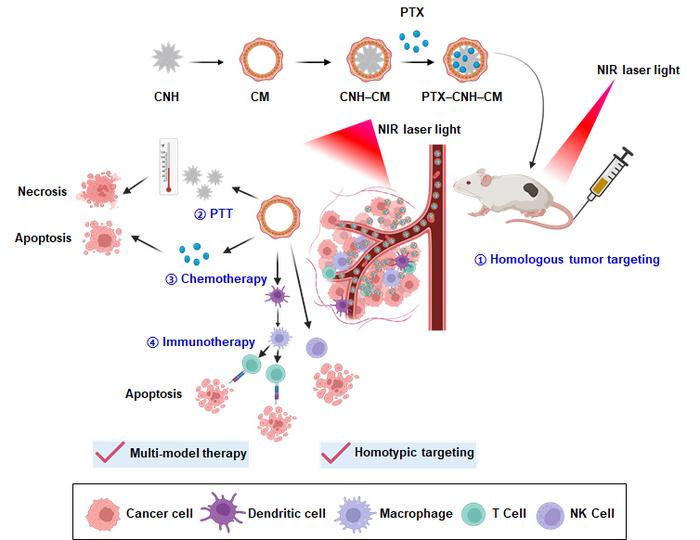Ishikawa, Japan — Cancer remains one of the most challenging diseases to treat due to its complexity and tendency to metastasize (spread into, or invade, nearby tissues or distant places in the body to form new tumors). Traditional therapies, such as chemotherapy and radiation, often face limitations like non-specific targeting and severe side effects. In response, researchers are turning to innovative approaches that combine multiple therapeutic modalities to address these issues. This study explores a cutting-edge solution involving CNHs to create a multimodal cancer phototheranostic platform integrating photothermal therapy (PTT), immunotherapy, and chemotherapy.

Credit: Eijiro Miyako from JAIST.
Ishikawa, Japan — Cancer remains one of the most challenging diseases to treat due to its complexity and tendency to metastasize (spread into, or invade, nearby tissues or distant places in the body to form new tumors). Traditional therapies, such as chemotherapy and radiation, often face limitations like non-specific targeting and severe side effects. In response, researchers are turning to innovative approaches that combine multiple therapeutic modalities to address these issues. This study explores a cutting-edge solution involving CNHs to create a multimodal cancer phototheranostic platform integrating photothermal therapy (PTT), immunotherapy, and chemotherapy.
PTT utilizes light-sensitive materials that can induce photothermal effect [conversion of near-infrared (NIR) light to heat] and activate immune responses to destroy cancer cells. While PTT is effective in targeting solid tumors, it has significant limitations. One major drawback is its inability to eliminate cancer cells outside the irradiation region, making it less effective against metastatic diseases. Additionally, PTT’s efficacy is limited by the depth of NIR light penetration, which can hinder its ability to treat deep-seated tumors.
To address these limitations, a team of researchers led by Associate Professor Eijiro Miyako from the Japan Advanced Institute of Science and Technology (JAIST), have now developed cancer cell membrane (CM)-wrapped CNH nanoparticles for the delivery of paclitaxel (PTX) for the treatment of colon cancer. These nanoparticles leverage the unique properties of CNHs and the targeting capabilities of cancer cell membranes. By using cancer membranes, the nanoparticles can specifically target cancer cells, thereby enhancing the precision of PTT. Their research findings were published in Small Science.
To further improve therapeutic outcomes, researchers encapsulated the chemotherapeutic or anticancer drug PTX within the CNH‒CM complexes. These nanoparticles were designed not only to deliver therapeutic agents directly to tumors, but also to maximize the efficacy of the drug. They tested these nanoparticles for tumor targeting, drug delivery, and therapeutic effects in experimental models.
The researchers discovered that the PTX-CNH‒CM complexes exhibited high accumulation and prolonged retention at the tumor site. This resulted in a stronger chemotherapeutic effect compared to free PTX. Additionally, the nanoparticles demonstrated a robust photothermal effect and significant immune responses, effectively destroying tumors.
“The high surface area and unique properties of CNH enhances drug loading and photothermal conversion efficiency. In addition, CM enables targeted delivery, while the encapsulated PTX and immunotherapeutic properties of the carrier provide additional therapeutic benefits. Thus, the integration of PTT, immunotherapy, and chemotherapy within a single platform resulted in synergistic effects, overcoming the limitations of standalone PTT,” explains Dr. Miyako.
The biomimetic CNH nanocomplexes demonstrated excellent tumor-targeting, controlled drug-releasing behavior, and cancer cell death induction, leading to a strong antitumor response. These findings suggest that the biomimetic CNH complex system represents a promising avenue for developing more precise and effective cancer treatments, marking a significant advancement in cancer therapy.
“Our study provides an effective and precise approach for the treatment of cancer and metastatic diseases by combining the advantages of multiple therapeutic modalities into a single platform. We anticipate that this technology will be available for clinical trials in 10 years,” concludes Dr. Miyako.
###
|
Title of original paper: |
Biomimetic functional nanocomplexes for photothermal cancer chemo-immunotheranostics |
|
Authors: |
Nina Sang, Yun Qi, Shun Nishimura, and Eijiro Miyako* |
|
Journal: |
Small Science |
|
DOI: |
10.1002/smsc.202400324 |
About Japan Advanced Institute of Science and Technology, Japan
Founded in 1990 in Ishikawa prefecture, the Japan Advanced Institute of Science and Technology (JAIST) was the first independent national graduate school in Japan. Now, after 30 years of steady progress, JAIST has become one of Japan’s top-ranking universities. JAIST counts with multiple satellite campuses and strives to foster capable leaders with a state-of-the-art education system where diversity is key; about 40% of its alumni are international students. The university has a unique style of graduate education based on a carefully designed coursework-oriented curriculum to ensure that its students have a solid foundation on which to carry out cutting-edge research. JAIST also works closely both with local and overseas communities by promoting industry–academia collaborative research.
About Associate Professor Eijiro Miyako from Japan Advanced Institute of Science and Technology, Japan
Dr. Eijiro Miyako is an Associate Professor at the Materials Chemistry Frontiers Research Area, Japan Advanced Institute of Science and Technology (JAIST). He has been a visiting scientist at Centre National de la Recherche Scientifique (CNRS) (France) and Nanyang Technological University (Singapore). He also served as the Senior Researcher at National Institute of Advanced Industrial Science and Technology (AIST), Japan. His research interests are in the areas of Bioengineering, Materials Chemistry, Nanotechnology, and Nanomedicine. Dr. Miyako received his Ph.D. in Chemical Systems and Engineering from Kyushu University (Japan) in 2006. He has received research prizes and awards such as PCCP Prize in Royal Society of Chemistry and Research Encouragement Award in The Fullerenes, Nanotubes and Graphene Research Society.
Funding information
This work was financially supported by Japan Society for the Promotion of Science (JSPS)
KAKENHI Grant-in-Aid for Scientific Research (A) (Grant No. 23H00551), JSPS KAKENHI
Grant-in-Aid for Challenging Research (Pioneering) (Grant No. 22K18440), the Japan Science
and Technology Agency for Adaptable and Seamless Technology Transfer Program through
Target-driven R&D (Grant No. JPMJTR22U1), Institute for Fermentation, Osaka (IFO), and
the Uehara Memorial Foundation.
Journal
Small Science
Article Title
Biomimetic functional nanocomplexes for photothermal cancer chemo-immunotheranostics
Article Publication Date
19-Aug-2024



